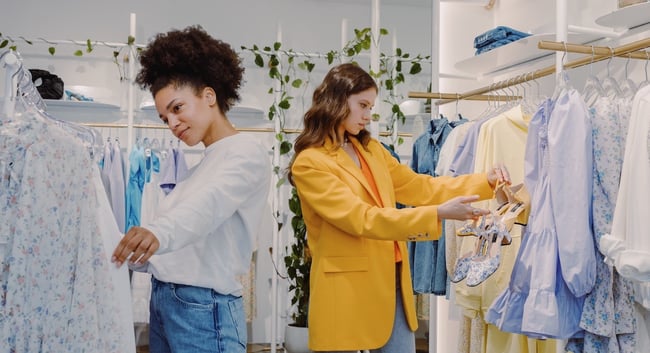Ecommerce Keyword Research: What Fashion and Apparel Customers Want
Written By: Doug Bonderud
Expanding digital shelves have created an increasingly competitive fashion and apparel industry.
It began with established brands moving into ecommerce — which grew rapidly over the last two years. Then, another big boost occurred, as familiar fashion houses and direct-to-consumer (DTC) brands started offering benefits such as faster shipping, free returns, and enhanced customer service.
The result is a dual challenge: For legacy brands, boring product detail pages (PDPs) that aren’t well-optimized for search can negatively impact sales numbers. And for DTC-focused companies, even a unique value proposition may not be enough to get noticed.
To help stand out from the crowd and drive clothing conversions, companies need to understand why trends are changing, what consumers are searching for in the fashion and apparel industry, and where they can improve strategies to drive sales.
What Do Fashion and Apparel Consumers Care About?
According to research firm McKinsey & Company, 67% of consumers surveyed in the U.K. and Germany say that the use of sustainable materials in fashion is an important purchasing factor.
As noted by data from Genomatica, one in three U.S. consumers would shop exclusively at sustainable clothing stores if the option was available. Triple Pundit also highlights the role of ethical manufacturing — which includes fair wages and working hours — as an emerging priority for U.K. buyers.
And, in France, the government is considering a “sustainable textile bonus” for companies that produce clothes using eco-friendly processes and materials, which would reward businesses that help reduce their environmental impact.
As reported by The Connexion, brands that leverage recycled materials or produce clothes designed to last longer could access a series of financial incentives. While there won’t be any fines for non-sustainable brands, the message is clear: Fast fashion is out. Sustainable and ethical are in.
Customers are also looking for more gender-neutral clothing options, as noted by Retail Dive. From March 2020 to July 2021, 11 major brands launched gender-neutral lines to capture a broader range of consumers.
Consumer Search Trends in Fashion and Apparel
So what are consumers searching for online in their quest for fashion and apparel?
According to data from Google Trends, terms including “sustainable clothing,” “sustainable fashion,” and “ethical clothing” have all seen steady search volumes over the past 12 months, with spikes at the beginning of this year followed by occasional peaks and valleys.
However, the term “online clothing” far outpaces all three eco-conscious terms. For both established brands and growing DTC efforts, there’s a simple inference: Demand for online apparel remains high, but consumers are now starting to modify their search habits as new purchasing priorities emerge.
How Are Brands Changing To Meet These Needs?
To help capture consumer attention, brands are using new products and processes to demonstrate their sustainable commitments.
For example, Retail Dive notes that Nike recently introduced a new material called Forward, producing a 75% lower carbon footprint compared to the brand’s standard knit fleece.
And according to Vogue, brands like Stella McCartney, Adidas, and Lululemon are now backing options like Mylo, a form of “un-leather” that goes through the same tanning process as regular leather but is made mostly of fungi roots.
Other material moves include the use of recycled textiles such as Circulose, which is made entirely from discarded clothes. This textile has already been used for an H&M product line and Levi’s iconic 501 jeans.
Who’s Doing It Right?
Amidst quickly changing market conditions, some brands are tapping into online fashion trends the right way.
Consider Reformation, which uses 90% recycled cashmere to make its sweaters. The company is already certified climate neutral, with plans to be climate positive by 2025.
Or, look at Everlane, which is committed to ethical manufacturing. Not only does the brand show day-to-day footage of what happens in their factories, but also requires all factories to score 90/100 or better on a workplace compliance audit.
Then there are companies like Princess Awesome and its brother brand, Boy Wonder, that create science, technology, engineering, and mathematics (STEM)-focused clothing for girls and bright, colorful clothing for boys to help break down gender stereotypes.
How Brands Should Alter Their Fashion and Apparel Keyword Strategy
With consumer keyword preferences changing, companies must have PDPs that align with customer searches and keep them coming back.
In practice, this starts by ensuring that information on PDPs is always up-to-date and that product pages make the best use of enhanced content such as 360-degree views and comparison charts.
It also means creating a consistent brand presence across websites, social channels, and brick-and-retail stores to ensure that company values are front-and-center in every interaction.
Finally, companies need to consider that even as some preferences change, others stay the same, such as consumer demand for streamlined checkout processes, fast delivery, and easy returns.
Bottom line? Being fashion forward in a digital-first market means adapting strategies to meet new consumer keyword preferences around sustainable, ethical, and gender-neutral apparel.
Make sure your brand is on track for ecommerce success with Salsify’s “KPIs for Ecommerce Cheat Sheet.”
Written by: Doug Bonderud
Doug Bonderud (he/him) is an award-winning writer with expertise in ecommerce, customer experience, and the human condition. His ability to create readable, relatable articles is second to none.
Recent Posts
5 Ecommerce Tips To Help Marketers Enter the New Year Stress-Free
How Many Digital Sales Channels Do Shoppers Review Before Purchasing Products?
What the Data Says About Consumer Interest in AI Shopping Agents
Subscribe to the Below the Fold Newsletter
Standing out on the digital shelf starts with access to the latest industry content. Subscribe to Below the Fold, our monthly content newsletter, and join other commerce leaders.


.svg)